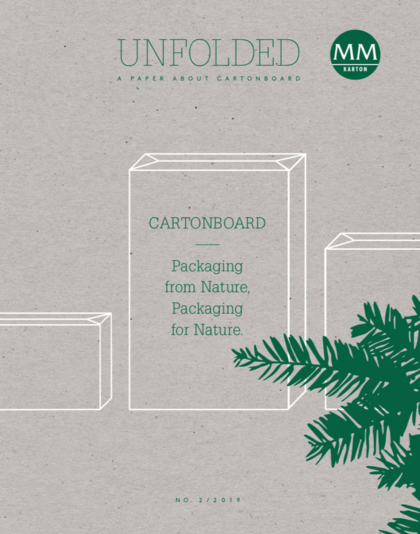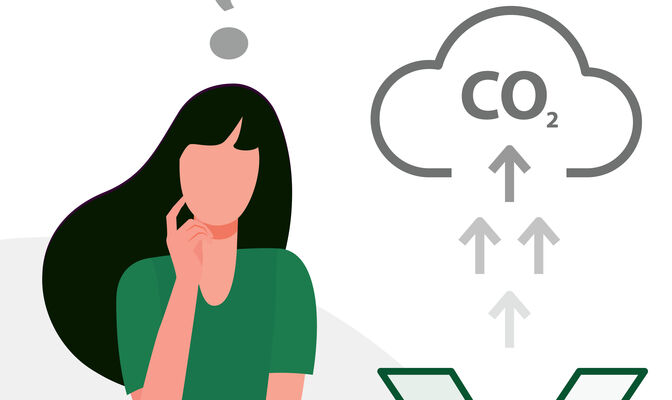Glossary
06.10.2019 - Cartonboard Know-How
Below glossary explains terms, often used in connection with sustainability, packaging materials, important regulations and central associations.
Technical Terms
Biodegradable / compostable
The term “biodegradable” describes a chemical process by which micro-organisms present in the environment convert organic material into natural substances like water, carbon dioxide and compost. No artificial additives are required. The process depends on the environmental conditions (e.g. place, temperature) of the material and the applications.
According to the standard EN 13432 a material is compostable if at least 90 % of it can be biodegraded in an industrial composting plant within 6 months.
Bioplastics
Plastics from renewable raw materials are often called bioplastics or biopolymers, although these and other terms – for instance “bio-based” – have not been clearly defined up to now and often lead to misunderstandings when associated with biodegradability. Biodegradable plastics can be based on both renewable raw materials and petrochemical raw materials. The degradability of the materials is in the end determined by their chemical and physical microstructure and not the origin of the raw materials or manufacturing process involved. Bioplastics are bio-based, can be biodegradable but are not necessarily so.
Disadvantages of bioplastics are industrial farming which has a negative effect on the environment, genetic engineering, food competition (e.g. bags made of corn or potato starch) and limited recyclability or industrial composting. In a position paper all the relevant associations of the German waste economy fundamentally rejected the composting of biodegradable plastics. Bioplastics can impair the quality of the compost since it cannot be ensured that within the available period, they can actually biodegrade so that there are no remaining particles larger than one millimetre, which would be defined as foreign objects.
Recycled plastics
Although plastics can technically be recycled, in practice collection as well as careful separation of sufficient quantities are difficult. Mixed collection plastic waste can generally not be recycled to the same high quality. Recycled plastics are therefore inferior in terms of quality, operability and safe availability as new goods. Whether recycled plastics are cheaper than those produced new from oil depends on the price of the oil. Therefore “environmental friendliness” is generally the only motive for using it.
Single Use Plastics
This describes certain plastic products designed to be used only once.
Over 50 % of plastic waste on European beaches consists of single use plastics. Of this around 86 % falls into ten common product groups. With its Single Use Plastic Strategy the EU will from 2021 therefore ban single use plastic products for which there is already a more eco-friendly alternative, such as plastic cutlery, plastic plates, straws, cotton buds made of synthetic material, plastic balloon sticks, oxo-degradable plastics and food containers and cups made of expanded polystyrene.
Microplastics
Microplastic are very small particles (<5 mm) of plastic. They are found increasingly in oceans and inland waters, but also in food and drink. There are many sources of microplastic. Either it is consciously added to commercial products (primary microplastics e.g. in washing powders, toiletries and cosmetics) or it is created in the degradation of larger plastics (secondary microplastics e.g. tyre abrasion while driving, washing of synthetic textiles, degraded plastic packaging) by UV radiation or weathering processes.
An estimate by the International Union for Conservation of Nature (IUCN) assumes that annually 3.2 million tons of microplastics find their way into the environment. Microplastic can get into the soil through, e.g. sewage sludge. Via rivers, waste water or municipal waste water channels microplastic particles are washed out into the oceans. In our food chain we absorb microplastic through fish or sea salt. No details are yet known about the actual effects on humans.
Monomaterial
Monomaterial is made primarily from just one type of packaging material. This applies not only to the different kinds of packaging (plastic or paper), but also the different types of material within the same kind of packaging (such as PP and EVOH from the group plastics). Here several layers of the relevant material can be used. The use of just one basic material enables later sorting and recycling. The German Packaging Act sets a proportional rule of 95/5, i.e. monomaterials must consist of a main material to at least 95 %.
Composite material / Composite packaging / Multilayer
Composite packaging consists of a combination of two or more different packaging materials which cannot be separated by the final consumer and which – according to the German Packaging Act – do not exceed a mass proportion of 95 %. Paper coated on both sides and paper coated on one or both sides with paraffin or wax or impregnated paper are also termed composite materials.
Oxo-degradable plastics
Oxo-degradable plastics are treated with additives like cobalt so that they will dissolve after a certain period of time. However, they do not dissolve completely but instead degrade into “microplastics” whose particles are smaller than 5 mm. Under the EU Single Use Plastics Directive products made of oxo-degradable plastics will be banned from 2021.
Polystyrene
Polystyrene is a transparent, foamed white, amorphous or partly crystalline thermoplastic. Expanded polystyrene is primarily known under the trade name styrofoam and is used mainly for food packaging and – in its foamed form – for sound and heat insulation. In the course of the Single Use Plastic Directive polystyrene packaging for food and drink will be banned from 2021.
STANDARDS / REGULATIONS / DIRECTIVEs
EN 13430 – Recyclability
EN 13430 describes the possibility of material recyclability. Packaging should be designed in such a way that the raw materials used can be recycled via the standard sorting systems or standard stock preparation systems. Packaging consisting of several materials must be constructed so that the consumer can separate them. Cartonboard is simply collected with paper waste and is born again as cartonboard in a recycling facility.
EN 13432 – Compostability
EN 13432 describes the requirements and procedures for compostability. Besides basic biodegradability in laboratory testing, the aerobic fermentability of the individual packaging materials must be proven in practice. The packaging components must not have any negative effects on the quality of the compost.
EU Circular Economy Package
At the end of 2015 the EU Commission passed the EU Circular Economy Package. Its goals were on the one hand to reduce waste to a minimum in order to prevent further pollution of the oceans with plastic and on the other hand to preserve the raw materials and associated created value within the Union and thus strengthen global competitiveness. In order to achieve the goal of a circular economy the EU is relying on three principles:
1. Reuse and recycling
2. Market bans and market restrictions
3. Pollutor pays
The Circular Economy Package is divided into two parts with the legislative proposals on waste (what is known as the Waste Package) on the one hand and the action plan on the other. In the Waste Package the EU Commission examines four directive proposals to revise existing waste directives. The Action Plan, alongside over 50 measures for the whole product life cycle (from products and consumption to waste disposal and the market for secondary raw materials), also contains a time schedule for final implementation of these measures and accompanying supervision. In five primary areas (plastics, food waste, critical raw materials, building and demolition materials, biomass and bio-based substances) the transition to the circular economy is to be accelerated.
Single Use Plastic Strategy (Directive (EU) 2019/904)
In March 2019 the European Parliament agreed with the Member States to a restriction of single use plastic products: at the latest by 2021 products made of single use plastics for which there are already more eco-friendly alternatives, such as plastic plates, plastic cutlery, food and drinks packaging made of styrofoam (expanded polystyrene), straws, stirring sticks, balloon sticks, cotton buds, all products from oxo-degradable plastics – are to be replaced by more eco-friendly alternatives. The use of plastic food containers for takeaway or fast food products (e.g. burger packaging) and plastic cups should be significantly reduced and replaced by more eco-friendly packaging.
Directive 94/62/EC on packaging and packaging waste
Directive 94/62/EC has the goal of harmonising various measures by the Member States in the field of packaging and packaging waste management and securing a high level of environmental protection. Packaging waste should primarily be reduced and unavoidable waste reused in order to achieve a reduction in the packaging waste discarded.
Packaging Act (Germany)
The German Verpackungsgesetz implements into German law the European Packaging Directive 94/62/EC. The Act replaced the existing Packaging Ordinance in 2019 and applies to all packaging brought into circulation in Germany.
The most important new rules of the Packaging Act are higher recycling rates and incentives (lower participation fees) for the design of recyclable packaging, the use of recycled materials and renewable raw materials.
Here the German Packaging Act distinguishes between packaging which typically ends up with a private consumer after use (B2C), for which there is an obligation to participate in the system, and packaging in the commercial sector (B2B). Manufacturers, traders and importers who act as initial distributors in Germany for B2C packaging for which there is an obligation for system participation, must become part of a (dual) system to ensure the comprehensive return and reutilisation of the corresponding packaging waste and register with the Central Agency Packaging Register (ZSVR). Initial distributors and secondary distributors (traders) of B2B packaging must take back similar packaging waste free of charge and add this to a proper recycling system.
The level of the participation fee is established by “ecological” criteria. If the packaging is easily recyclable or if it consists of (partly) recycled materials, then the participation fee is lower. The ZSVR together with the German Environment Agency has issued a (provisional) guide. This defines criteria for recyclable design and thus describes a development framework for how recyclability can in future be quantified within the context of the Packaging Act.
Directive 2008/98/EC on Waste
The Waste Directive 2008/98/EC establishes the legal framework for waste legislation in the Member States. The directive sees its goal as “preventing or reducing the adverse impacts of the generation and management of waste by reducing overall impacts of resource use and improving the efficiency of such use.“ In the Framework Waste Directive a 5-step hierarchy is established for dealing with waste which prescribes the Member States a priority scale for the measures to be established nationally:
1. Avoidance
2. Preparation for reuse
3. Recycling (materials)
4. Other reuse
5. Disposal
Directive 1999/31/EC on the Landfill of Waste
The directive contains strict company-related and technical requirements for waste disposal sites and waste. The intended measures, procedures and guidelines should go as far as possible towards avoiding or reducing all negative influences on the environment and the associated risks to human health which can occur through landfilling.
ASSOCIATIONS
CEPI – Confederation of European Paper Industries
The CEPI is a non-profit organisation with its headquarters in Brussels. The CEPI represents approx. 500 companies of the cellulose and paper industry within the European Union. The aim is to improve the image and perception of the paper industry and its associated industries and to combine competitiveness with sustainability.
Pro Carton
Pro Carton is the European association of the carton and folding box industry. Its goal is to encourage cartonboard and folding boxes as a packaging medium in the fields of brand items in industry and retail, as well as in design, media and politics.
ECMA – European Carton Makers Association
ECMA is an European network of folding box manufacturers, cartonboard producers, national associations and suppliers of the carton industry. ECMA offers several network platforms for the exchange of information and publishes among other things industry guidelines such as the ECMA Good Manufacturing Practice Guide.
VDP – Verband Deutscher Papierfabriken
The Association of German Paper Factories is the industrial umbrella association for the German cellulose and paper industry and represents the interests of its members regarding energy, environment, technology and research on a national level.
FFI – Fachverband Faltschachtel-Industrie
The Professional Association of the Folding Box Industry represents producers of folding boxes with sites in Germany in discussions with the supplier industry, politics and business and also represents their interests on the international stage.
CPI – UK's Confederation of Paper Industries
CPI represents British paper and cartonboard industry companies. Goals include securing the provision of energy at competitive prices, efficient use of resources and a sustainable British paper industry. Together with WRAP, the CPI has published a guideline for the design of recyclable packaging.
WRAP – Waste Resource Action Program
WRAP is an international programme for avoiding waste and saving resources or using them efficiently. In order to achieve these goals WRAP works together with governments, companies and local governments in the fields of design, production and sales, utilisation and consumption, as well as reutilisation and recycling.



